Darrell Brooks trial: Defendant cries during opening statement

Darrell Brooks trial: Defendant's opening statement doesn't reveal why jury should acquit
During his opening statement in the Waukesha Christmas parade attack, Darrell Brooks removed his mask to show the jury "who he really is." Brooks stopped short of spelling out why the jury should find him not guilty on six counts of first-degree intentional homicide and 70 other charges. He did say he believes they'll make the "right decision."
WAUKESHA, Wis. - Prosecutors on Thursday, Oct. 20 rested their case in the Darrell Brooks trial, charged in the November 2021 Waukesha Christmas parade attack. The state called 57 witnesses to testify over the two weeks of the presentation of prosecutors' case-in-chief.
After the prosecution rested, the court took its lunch break for the day. Immediately following the break, Brooks cried as he delivered his deferred opening statement to the jury. Brooks then called two witnesses to testify Thursday (technically three, but one was denied by the court.)
Through three witnesses Thursday (one who previously testified out of order) and his opening statement, Brooks' defense strategy seemed unclear.
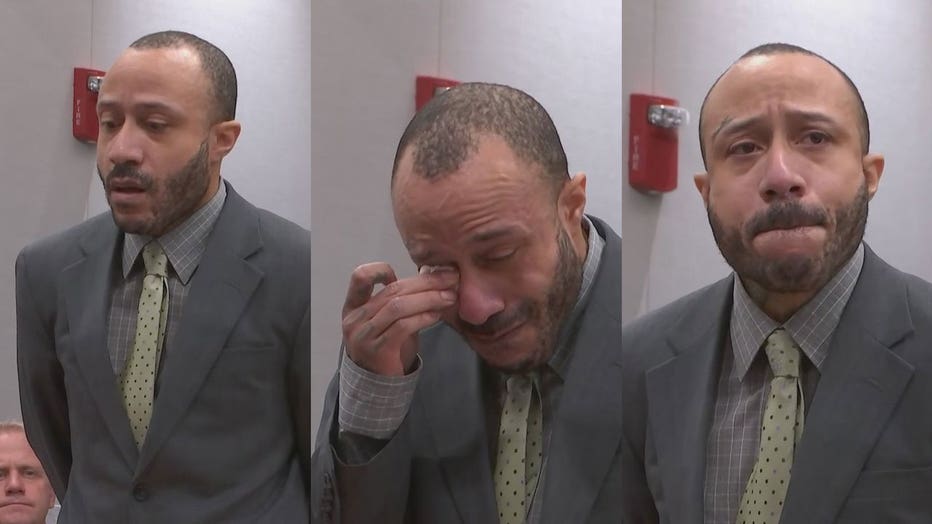
Brooks gets help preparing his opening statement
As court began Thursday, Judge Jennifer Dorow noted she gave Brooks an excerpt from her judicial bench book on opening statements that she believed "would be helpful to provide to Mr. Brooks as he puts together his opening statement." She said this document contained references to Supreme Court rules, case law, manner and purpose, scope, etc. for his opening statement, which the judge said could help him to establish his roadmap/framework so that the jury can better understand his evidence.
She noted that his opening statement would need to be "based on the law and evidence you believe is properly admissible."
She said his opening statement must not contain reference to subject matter jurisdiction, something Brooks brought up multiple times every day during the trial.
Brooks noted he was "pretty aware that subject matter jurisdiction wouldn't be part of my opening or closing statement."
"Okay. Great," said Dorow.

Darrell Brooks
"Even though it hasn't been proven on the record, and it should be addressed," said Brooks.
The judge noted it did not need to be proven on the record and again referred to her written statement on the matter issued Friday, Oct. 14.
"Jurisdiction was commenced when the complaint was filed," said Dorow.
District attorney's motion to amend the complaint
The court then addressed a motion Waukesha County District Attorney Sue Opper said was served on Brooks Wednesday night in jail.
Brooks said he did not look at the document.
"I accept for value and return for value the document..." said Brooks. "I don't know what I'm supposed to say on that."
In the motion, prosecutors moved to amend the information regarding the location of Count 76, which read "at Frame Park." Prosecutors asked to change it to "near Frame Park." This particular count relates to the fight prosecutors say Brooks was involved in with his ex-girlfriend, Erika Patterson, before the Christmas parade attack. Prosecutors argued that this change would be more in line with Patterson's testimony.
They noted that "it's a very small change in the charging documents."
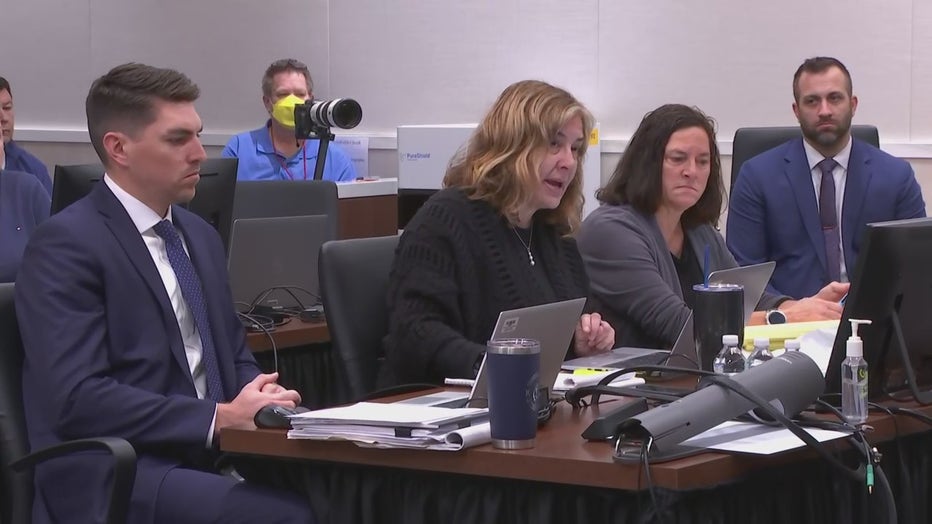
Prosecution in court Thursday, Oct. 20
Brooks argued that this case had been charged for "the better part of a year."
"If there was one word that needed to be changed, there was ample time for it to be changed," he said. "I don't think one word, at this time, really has any bearing on the testimony or the actual charge. It's been charged like this for a year, basically. The language hasn't been referenced to being changed until (Wednesday). What is the significance now, at this point?" said Brooks.
Judge Dorow referred to statutes stating the amendment of a complaint may be allowed if such amendment is not prejudicial to the defendant, when it doesn't change the criminal charge and when the offense/results are the same. Dorow granted the state's request.
Brooks said he was looking to call Patterson as a witness and asked "what will happen if the testimony changes."
Dorow said she would not speculate or give Brooks an advisory opinion on that.
Judge accepts state's request to recall Detective Casey
The court then discussed prosecutors' request to recall Detective Casey, who previously testified over two days earlier in the trial. Prosecutors noted there wouldn't be any duplication in their questioning. Rather, they said his first testimony focused on the parade layout, and they now wanted to ask about victim identification, driver identification and vehicle identification -- things that had been addressed in testimony since Casey was first on the stand.
Prosecutors argued that, "as the lead detective in the case," it would assist the jury in understanding some of the things on the back end that he was involved in.
Casey initially testified that Brooks hit him with the red SUV before the parade attack, and he tried to stop the vehicle. He was on scene after the parade attack and later became lead detective.
Brooks argued that he felt the state had been "efficient in their presentation." He said their arguments seemed to be "an attempt to get more questions in that could have been asked in the first place."
He noted that Casey testified "for quite some time," noting that his cross-examination of Casey occurred the day after his testimony.
"That was more than enough time for any other foundations to be laid, questions to be asked at that time," said Brooks.
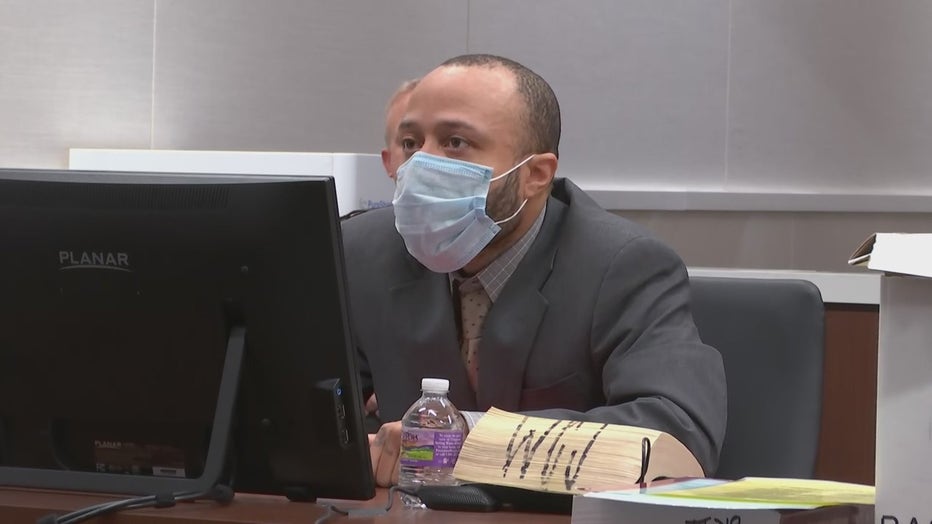
Darrell Brooks in court Thursday, Oct. 20
Brooks also argued that Casey was excused from his subpoena in this case after his prior testimony.
"He was asked to be excused, so essentially, having him start off and then end it, I feel like, is an attempt to get questions that was maybe forgotten to be asked answered," said Brooks. "What more could be gained by a second testimony from Casey? What more could we gain that hasn't already been learned? We've learned about vehicle ID through numerous witnesses...inspection of the vehicle...DNA analysis of the vehicle. We've been through numerous things in regard to the vehicle, even the reconstruction testimony. Seems like nothing more than to get extra questions answered that could have been asked from the get go."
Judge Dorow again cited statute and said she would allow Casey to be recalled for the reasons laid out by the state.
"His testimony today is not to rehash topics he was questioned about initially," said Dorow, noting it would have to do with his role subsequent to the initial contact with Brooks at the beginning of the parade route.
The judge also noted two charges for which the state had not yet presented testimony as of Thursday morning.
Brooks asked if he would be able to re-cross-examine Casey, and the judge said he would. Brooks followed up by asking whether anything would be off-limits during cross. Dorow said that would be a possibility depending on whether Brooks' questions dealt with what Casey testified to previously. Dorow noted statute states that a witness may be cross-examined on any issue in the case
but also says the judge may limit questions.
Dorow said she would give Brooks "leeway" in his cross of Casey.
Brooks prepares ‘counter’ plea offer
Finally, before the jury was brought in, Brooks noted the state's pre-trial offer, which would involve Brooks pleading guilty to certain counts and receiving six life sentences for the homicide charges plus unspecified prison on other convictions. Brooks claimed he never had that pre-trial offer until the trial. Prosecutors claimed it was given to Brooks' prior attorneys on at least two occasions.
Brooks said Thursday morning he was in the process of putting together "a counteroffer."
SIGN UP TODAY: Get daily headlines, breaking news emails from FOX6 News
Thomas Casey recalled by prosecution
The jury was brought into the courtroom around 9:10 a.m. Thursday, and Casey took the stand, recalled by the state. The detective went through the process of identifying people who were injured in the Waukesha Christmas Parade incident. He became the lead investigator on the case the night of the attack.
Casey told the court that police detectives were sent to five different hospitals to identify possible victims as they came in. As part of the process, the detective said, officials had to come up with parameters that would positively identify a true victim. He said the victims had to be in the street of the parade route and receive hospital care. The detective said people who were injured after the fact, from other instances, were not considered victims. In other words, there were more victims from the parade attack than those associated with the 76 total counts filed against Brooks in this case – including 61 counts of first-degree recklessly endangering safety related to the injured victims.
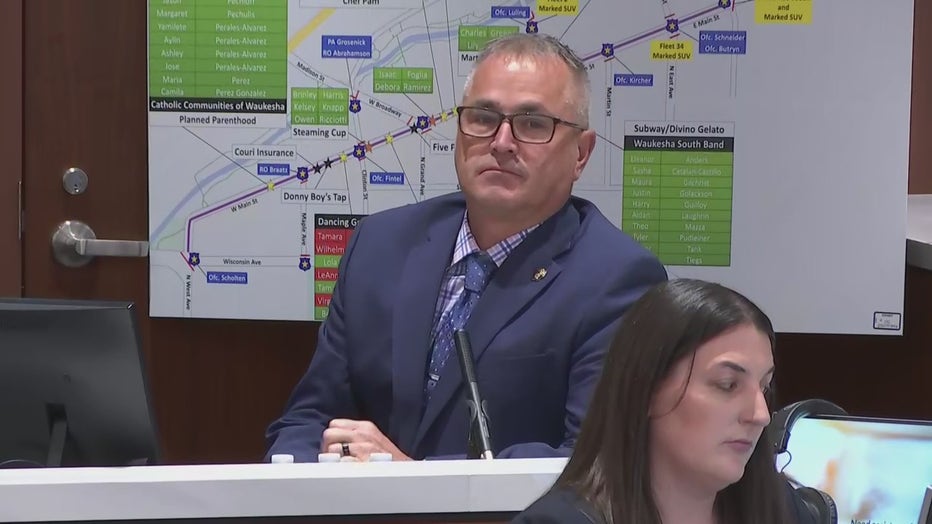
Waukesha Police Detective Thomas Casey
Casey indicated there were three other members of the Xtreme Dance Team – including a 10-year-old boy – who were injured in the parade incident but not listed on the state's charges. He also indicated a white hood and navy hat that belonged to Milwaukee Dancing Grannies member Virginia Sorenson, killed in the parade attack, was found on the red SUV that was later located in Waukesha.
The detective testified investigators obtained "300 to 400 videos" of the parade incident. He stated he watched all of them and asserted Brooks was driving the red SUV through the parade in all of them.
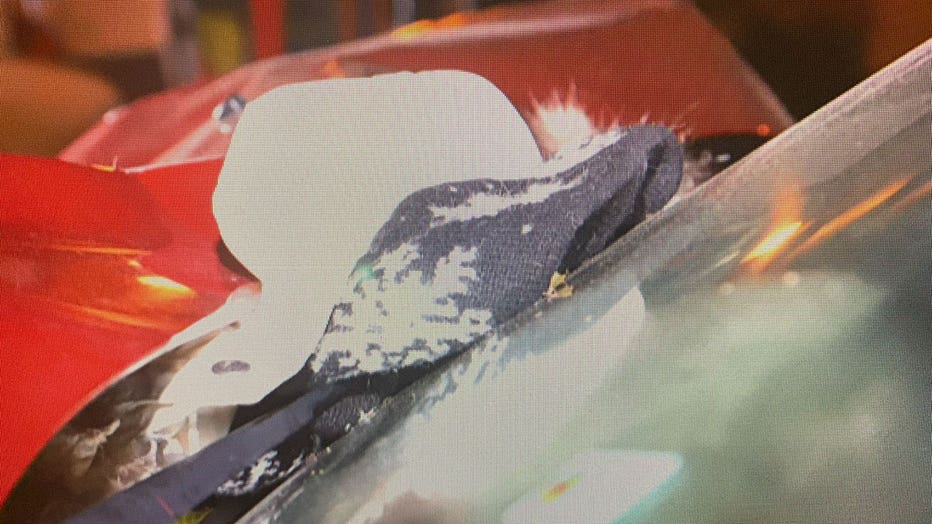
"I've never seen anyone driving the SUV other than the defendant. None of the videos we looked at showed anyone else in the vehicle," Casey said. "Never showed the vehicle coming to a complete stop on the parade route."
Some of the videos captured the license plate of the red SUV involved in this case. Casey testified police also found a video on social media where Brooks was recorded next to the SUV with matching plates. Brooks had his back to the camera in that video.
The detective testified that the SUV was found on Maple Road and that officials got a key from Brooks. At that time, Casey said, the red SUV was in processing, so he took the key there and it worked the door lock and the ignition lock of the vehicle. Casey also told jurors Brooks' fingerprints, the three women he has children with and Brooks' mother all identified the suspect in the parade incident as Darrell Brooks. However, Brooks objected to "being called that name."
"That's the name he's always gone by," Casey said.
The jury was shown video of the backyard of Dawn Woods, Brooks' mother, which showed a red Ford Escape – the type of SUV in question. That video was dated 1:26 p.m. on Nov. 21, 2021 – the afternoon of the parade attack. Casey testified that Woods gave police the video that night.
Brooks began his cross-examination of Casey around 10 a.m. During this cross, Brooks argued no one can tell who has their back to the camera in the photo that had been shown in court. Casey said he watched the entire video, and he testified it was indeed Brooks.
Casey further testified that he learned Brooks had use of the SUV at the time of the attack. He also said he had been to Brooks' mother's house to talk to her and knew the video of the SUV in the backyard on the afternoon of Nov. 21, 2021, was from that house.
Brooks asked Casey if the detective interviewed his child and if he had "heard the term double jeopardy." The prosecution objected. Casey continued to testify about what he saw at the scene.
"I remember a horn beeping and (Brooks) driving into me and not stopping when I pounded on the vehicle," said Casey, describing Brooks as looking angry. "I've been driving a long time. When people beep their horns, they are late or angry. That's why I concluded they were angry."

Darrell Brooks trial: Detective Casey presents state's final testimony, evidence
Darrell Brooks trial: Detective Casey presents state's final testimony, evidence
Casey added it was a possibility that someone would beep their horn to get out of the way. He testified speaking to Brooks' mother multiple times to gather more information and a warrant for Brooks' Waukesha County Jail cell that was served July 1, 2022.
"Why did you serve the warrant?" Brooks asked before again raising his "the state is an entity" questions, as he has throughout the trial.
"The jury will strike those comments," Dorow said, following prosecutors' objection.
Brooks questions music video state says shows him, red SUV
Brooks became frustrated with the state's objections during his cross-examination of Casey, and the judge sent the jury out around 11:10 a.m. for a legal discussion.
The discussion focused on a specific exhibit shown to Casey Thursday by the state, specifically, a music video prosecutors say Brooks appears in. Casey testified it was taken from Brooks' Facebook page. Brooks described it as "mind-boggling." The state initially showed Casey a still shot from the video which prosecutors said showed Brooks with his back to the camera. The video was played without audio for further identification purposes. During his testimony, Casey said he said he had "no doubt" that Brooks was the man in the video standing next to the red SUV.
Brooks argued he had never seen that video before, and it wasn't previously admitted.
"When was this video made an exhibit?" Brooks asked.
Opper argued the exhibit was included with the initial discovery materials sent to Brooks' former attorneys. Brooks again argued this video was never part of the information he received.
"I see what you people are trying to do, and it's not fair, and it's not right," said Brooks. "That video was not part of (initial discovery)."
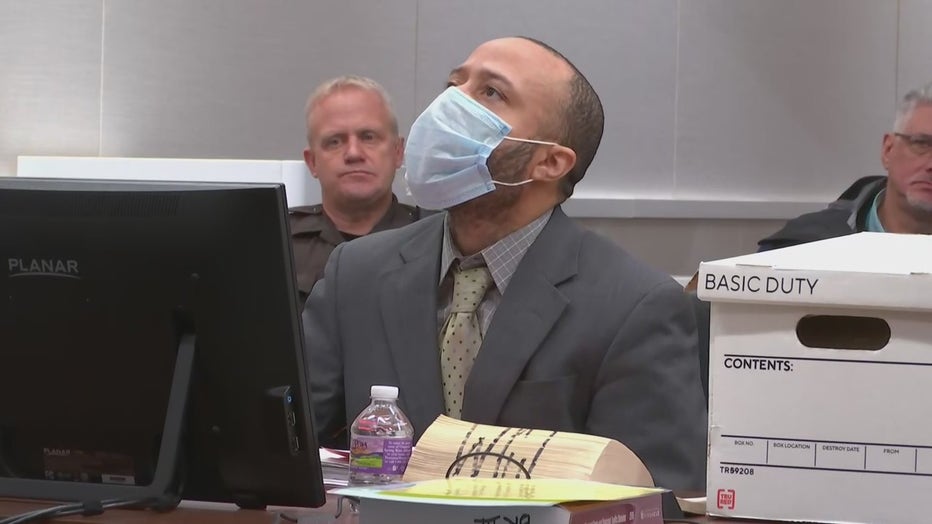
Darrell Brooks in court Thursday, Oct. 20
Judge Dorow said she was satisfied with the state's offer of proof that the video was previously submitted to counsel. Brooks asked if prior counsel could testify to that.
Dorow asked Brooks if he was familiar with the video, and Brooks asked what that had to "do with it." The judge noted it was a music video that Brooks was in, along with the red SUV.
"That video is relevant for a number of different reasons," said Dorow, adding that it would go to the identification of Brooks, the identification of the vehicle.
The judge noted Brooks "opened up the door" to this evidence during his cross-examination of Detective Casey regarding Casey's ability to identify Brooks.
"And when I say identification -- specifically as to Casey's opinion of whether that's you in the video," said Dorow, adding, "It's up to the jury to determine that."
"You directly attacked the credibility of Detective Casey through his knowledge of it and his identification of you in it because the still image of you in it was your back," said Dorow.
Brooks wanted to know why this video was made an exhibit "out of the blue" on Thursday morning.
Opper gets emotional
This led to an emotional statement from DA Opper regarding Brooks' actions in court.
"He challenges the court's authority repeatedly," said Opper. "This court absolutely has the ability to tell him to sit down and be quiet. You haven't done that, and we know why you haven't done that. We respect that."

Darrell Brooks trial: Waukesha County DA Sue Opper reacts to Brooks' actions in court
Darrell Brooks trial: Waukesha County DA Sue Opper reacts to Brooks' actions in court
Opper noted, as Dorow did, that the video was relevant based on Brooks' questioning of Casey challenging Casey's ability to identify the person with their back to the camera in the still shot.
"Trials are fluid," said Opper. "When he opened the door to that, we came up with the video, which Casey testified repeatedly as to how he know that was Mr. Brooks because he had seen the rest of the video."
Opper said she originally wasn't going to ask for the audio to be played but Brooks "pressed it again."
"His voice and his manner of speech would help the jury identify..." said Opper. "You smartly asked me to play it without the audio. This is all to the benefit of this defendant. He doesn't like it because the evidence is stacking up and stacking up. Whenever it does, his response is to accuse you and the prosecutors of being unethical."
Opper added that, "There is nothing in law that prevents me from pulling something out right now and making an exhibit."
"There is no law that I can't make an exhibit on the fly," said Opper.
Finally, as to Brooks actions, Opper stated, "I do not appreciate his impugning the integrity of these proceedings...of your Honor's efforts to run a fair trial and of our efforts to run a fair trial."
She addressed an accusation from Brooks that she was laughing during his cross, adding that she was laughing because an exhibit was labeled "EXHIBITY" on her computer.
As the judge and district attorney spoke, Brooks began interrupting.
"Stop gesturing me, rolling your eyes and talking over me," Dorow told Brooks.

Darrell Brooks trial: Judge Dorow, defendant spar over evidence, testimony in the case
Darrell Brooks trial: Judge Dorow, defendant spar over evidence, testimony in the case
Brooks got upset and started yelling about the prosecution laughing throughout the trial.
The judge admonished both parties.
Brooks responds
Brooks then argued Opper had been "laughing and talking under her breath the whole trial," telling the court, "I'm not an idiot."
"Why is something always funny at that table?" Brooks asked the judge.
"I think I deserve a chance to rebut what was just said," said Brooks. "For her to sit there and play this off…she must think I'm an idiot."
"That is not what happened," Dorow said as Brooks covered the microphone and laughed.
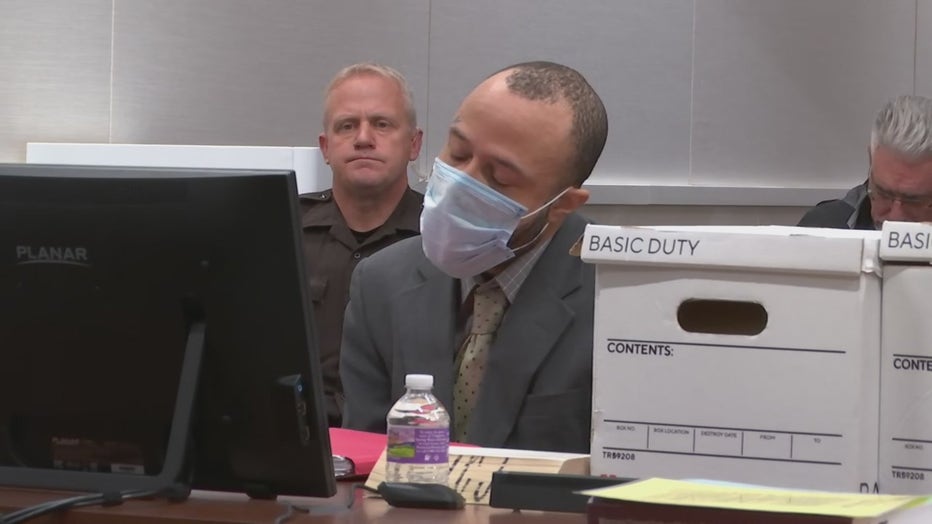
Darrell Brooks
He told the court that Opper had just admitted on the record that she just made the exhibit up that morning. The judge called that a mischaracterization and asked for a legal basis for his objection.
"So I'm just supposed to come up with that off the top of my head?" asked Brooks.
"Yes," said Judge Dorow.
"That's ridiculous," said Brooks.
"You're representing yourself. It's not ridiculous," said Dorow.
The judge then put Brooks on notice regarding his interruptions.
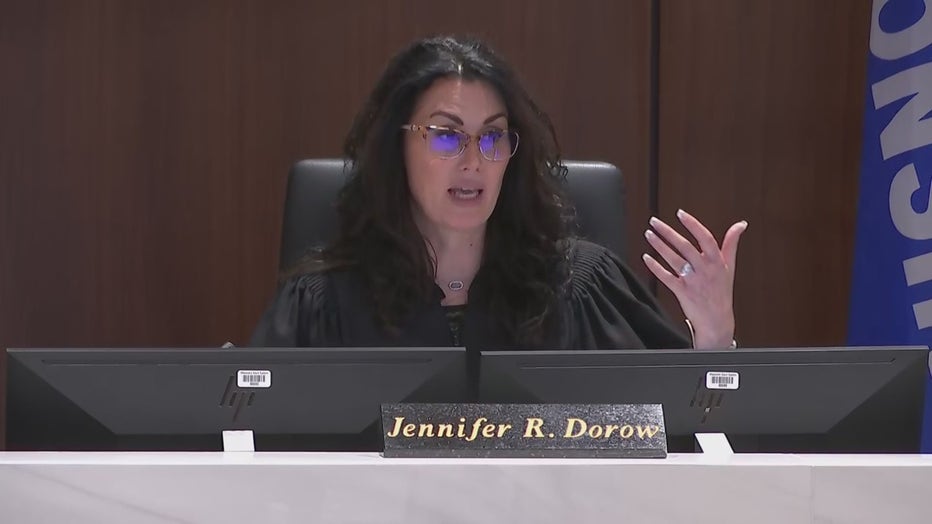
Judge Jennifer Dorow
Judge cuts off discussion, puts court into morning break
Before the morning break, the judge tried to address two other issues that came up during Brooks' cross of Casey. First, questioning by Brooks related to Casey speaking with Brooks' mother, Dawn Woods, in August, and references made to Brooks' niece and nephew. An objection by the state was sustained by the judge during cross.
The second issue related to questioning regarding Casey's search of Brooks' jail cell.
"Do you want the opportunity to question Detective Casey about these topics?" Dorow asked the judge.
Brooks would not answer the question and continued to argue with Dorow.
"Mr. Brooks, sit down. I don't care if you don't like my tone. You have been pushing my buttons all day, throughout this entire trial. And I have shown the utmost of respect for you, and I don't appreciate you impugning the integrity of this court."
Brooks interrupted the judge repeatedly during that statement, accusing her of also "pushing my buttons" and making inaccurate claims.
"Stop talking," Dorow said. "I need to make a ruling."
"What you mean, 'Stop talking?’" Brooks argued. "Let's talk to each other like adults then because I've never told you to stop talking."
She asked the question one more time as to whether Brooks wanted to question Casey about the two topics being addressed.
"If he doesn't answer, I will take it as a 'no,'" said Dorow.
Brooks said he did not understand the question.
The judge eventually cut off the discussion and put the court into recess.
Exhibit procedures addressed after Brooks' arguments
Upon return from the morning break, the court addressed Brooks' arguments regarding exhibits, specifically the music video.
"I don't think what I say doesn't much matter," Brooks said. "What I have to say about anything doesn't matter."
"This court takes your position on legal argument," Dorow said as Brooks interrupted. "You make disparaging remarks, roll your eyes. Just previous to the break I couldn't get a word in. You wanted to debate decisions already ruled on."
"Did I raise my voice? Was I frustrated? I absolutely was," Judge Dorow continued. "I just wanted to get through some issues outside the presence of the jury. That's the proper procedure."
Judge Dorow noted she asked the state to file an exhibit list, and said normally, as long as an exhibit has been provided to a party previously and as long as it has been turned over in discovery, the parties will have exhibits marked as they are presented during the trial. The judge said there's not a legal requirement unless a judge orders it to prohibit a party from marking a document that had already been exchanged and having it offered as an exhibit.

Darrell Brooks in court Thursday, Oct. 20
"There is nothing improper about what the state did, and I want to make that record very very clear," said Dorow.
"Trials are fluid," the judge said. "Things happen. Parties can open the door to what might be inadmissible evidence. For example, this court made pretrial warnings related to other acts evidence (this relates to information about other cases involving Brooks not being admissible in this trial). You came close. I had the witness (Casey) turn to me and say, 'I don't think I can answer that.' Casey understood his obligation to honor the pretrial rulings. I bet that's happened a half a dozen times. That's to protect your rights, sir."
Before the lunch break, the judge addressed Brooks' decision to testify, noting that it could impact his opening statement. The judge informed Brooks that he had a constitutional right to testify or not to testify, and it was entirely his decision.
As the jury came out shortly before the lunch break, Brooks brought up subject matter jurisdiction yet again.
"It should be proven at some point," said Brooks.
The state rested just before lunch around noon.
Brooks' opening statement
Brooks began his defense by presenting to the jury his opening statement, something he deferred at the beginning of the case. In it, he didn't provide details about what happened or lay out his defense, nor did he reveal who he would be calling to testify, despite being advised Thursday morning by the judge that the opening statement would allow him to provide a roadmap of his case.
He began by telling the jury, "There's two sides to every story."

Darrell Brooks trial: Brooks presents his opening statement to the jury
Darrell Brooks trial: Brooks presents his opening statement to the jury.
"I’ve watched for a year about the countless narratives, and finally, everyone gets the chance for the full story," Brooks said. "You won’t hear me try to argue facts. This was tragic."
Brooks choked back emotion as he continued to present his opening statement.
"This incident was not planned. It was not intentional," Brooks said. "There’s been a lot of suffering involved in this incident; a lot, obviously, with the families."
Brooks asked the jury to "keep in mind" the power that they have, saying it has been a "long process for everybody."
"Lot of speculation, lot of ridicule," said Brooks, wiping tears from his eyes. "Words like ‘demon.’ Words like ‘monster'…I know a lot of the time I've been before you, you've seen me with this mask on. I've had my reasons for that, but I feel now is the time that it's important that you see me for who I am. No mask. For who I am. I think this is the moment for that."
"I pray that your eyes and ears remain as open as possible. I understand that you alone decide this case, this matter," said Brooks, addressing the jury. "The power is in your hands – all of you – to determine for yourself what truth is. Thank you."

Darrell Brooks trial: Defendant cries during opening statement
Prosecutors on Thursday, Oct. 20 rested their case in the Darrell Brooks trial, charged in the November 2021 Waukesha Christmas parade attack. The state called 57 witnesses to testify over the two weeks of the presentation of prosecutors' case-in-chief.
Juan Marquez testifies for the defense, Waukesha Christmas Parade participant
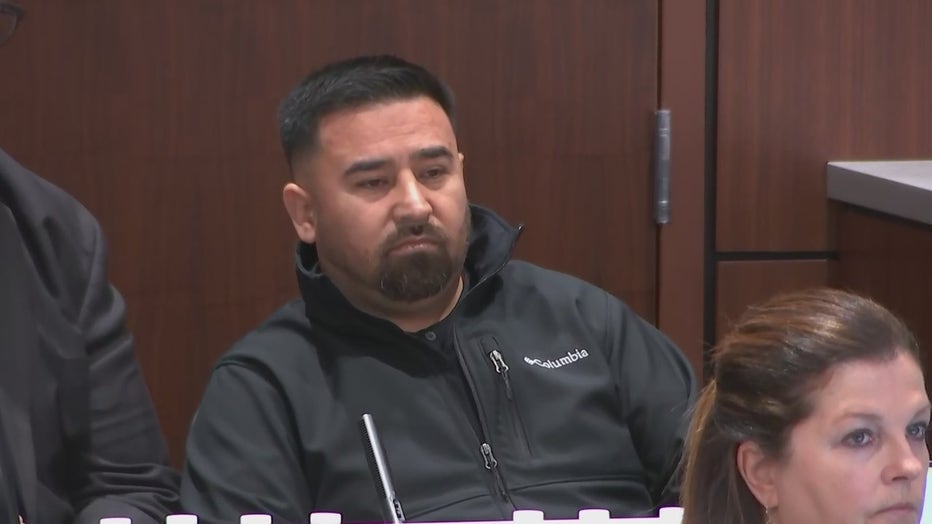
Juan Marquez
Juan Marquez was called out of order by Brooks on Oct. 18 during the presentation of the state's case-in-chief due to the need for a Spanish interpreter. He testified he was marching in the Waukesha Christmas Parade with his wife and son with the Catholic Communities of Waukesha when he was hit by a vehicle and thrown between 15-20 feet and his body "flew through the air." Brooks let it slip that Marquez originally told the FBI the SUV was black. Marquez told the court he could not remember what color the truck was that struck him on the parade route. Marquez said he never heard a horn honking.
Brooks calls ‘State of Wisconsin’ to testify
Brooks tried to call the "State of Wisconsin" Thursday as his first witness during the presentation of his case-in-chief. That was denied by the court.
Nicholas Kirby, with Kori Runkel (Brooks' ex-girlfriend's roommate) in Waukesha
Brooks then called Nicholas Kirby, who was with Kori Runkel, the roommate of Erika Patterson, Brooks' ex-girlfriend, on Nov. 21, 2021, in Waukesha.
Runkel testified for the state about a fight near Frame Park that preceded the attack involving Brooks and Patterson. Runkel said she was also present, along with a "Nick."
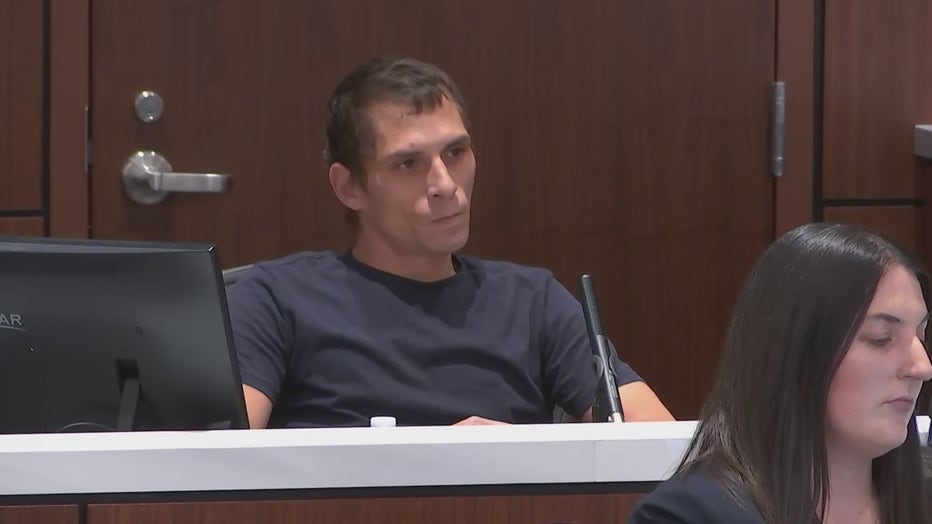
Nicholas Kirby
"Did you ever go to a park?" Brooks asked Kirby.
"No," said Kirby.
Brooks asked Kirby about making reference to knowing Darrell Brooks a week before.
"She showed me your rap sheet…" said Kirby of Patterson, whom Kirby said he had known for a couple weeks.
"I’ll stop you unless you want to go there – about priors," warned Judge Dorow.
Brooks asked about Kirby's meeting up with Patterson Nov. 21, 2021.
"We were walking towards the area where Erika was walking and saying she was being attacked," said Kirby.
Kirby said prior to that, he got a call from Patterson.
"When she said she was in trouble, I ran to where she told me to go," said Kirby.
Brooks asked if he provided a description to police of who was assaulting his friend. Kirby said he had a description of the vehicle.
"Ms. Patterson told me over the phone she was in a red SUV," said Kirby. "There aren’t many women in Waukesha screaming from a red SUV."

Brooks had an old exhibit pulled up, a video recorded near White Rock School, and asked Kirby if he saw anyone get into a red SUV seen in the video. Kirby said "no."
As he approached the area, Kirby said he heard Patterson scream.
"That's what caught my attention," he said.
He said "Patterson doesn't know Waukesha" and that she knew she was on White Rock but wasn't sure how far down she was.
"It wasn’t until I saw the red SUV parked in front of the apartments that I knew where she was there," said Kirby.
Kirby testified that Runkel saw Patterson before he did and said, "She's over there."
"We went across the street, and there was Ms. Patterson, hobbling down the street with fluid on her leg," said Kirby.
Brooks asked if, while walking with Runkel, he saw Patterson in the SUV. Kirby testified Runkel was with him when the phone call came in about Patterson being in trouble. He said he would assume if someone told him they were in a vehicle, they were in a vehicle. He said Patterson may not have been in the vehicle when he got there.
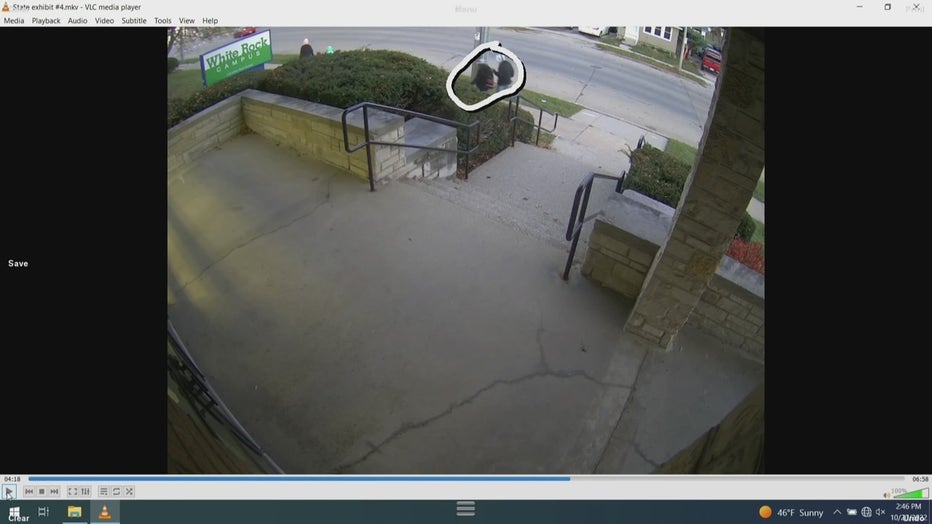
Nick Kirby and Kori Runkel walk past White Rock School
Referencing the video, Brooks pointed to people seen walking in the area and asked if Kirby remembered people in that area near White Rock School.
"I was only focused on the one, and that was the one in danger," said Kirby.
He said he could not see Patterson at that point.
Kirby said he was on the phone with Patterson when he was near White Rock and Hartwell, and she said she was near some red apartment buildings. He still could not see Patterson.
Brooks then pointed to Kirby and Runkel seen walking past White Rock School in the video. They still could not find Patterson. Kirby said he was trying to call her at that point, and she wasn't answering.
"That scared me, so I told Kori to keep an eye out and keep looking for her, while I kept calling her," said Kirby.
Kirby said Runkel finally spotted Patterson near Frame Park and a boat launch. They grabbed her and started to leave.
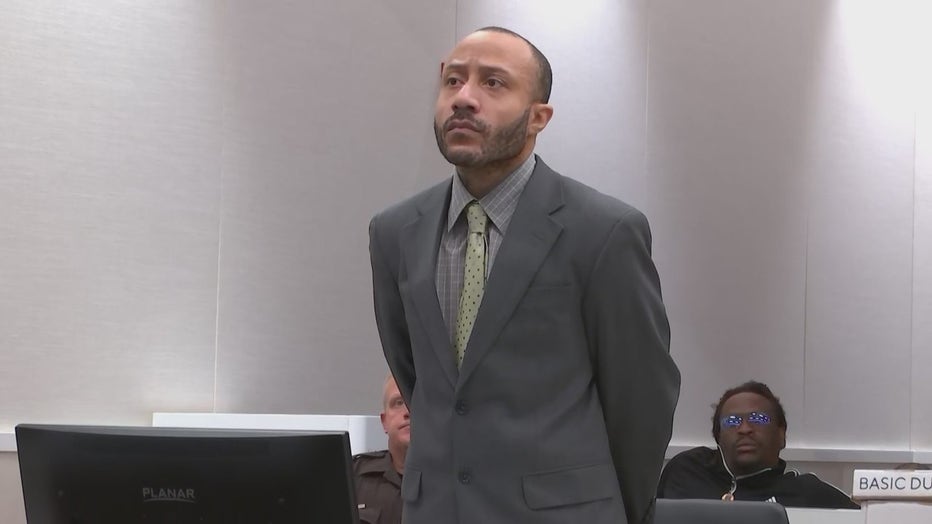
Darrell Brooks in court Thursday, Oct. 20
Brooks asked if Patterson was inside the SUV. He said she was not.
Brooks followed up by asking when, if at all, he saw Patterson in the vehicle. Kirby said she did when she went into the vehicle to grab her things.
Kirby said the first time he saw the red SUV was after zig-zagging up White Rock with Runkel. He said it was parked in front of some apartments, and Patterson came from the passenger side. He assumed she had just gotten out of the vehicle. Brooks asked if he knew that for sure.
"I am not actually sure if she was in the vehicle at that time," said Kirby. "I was just going off of what she said on the phone, so my assumption was that she was in the vehicle."
Brooks asked to play a different video previously admitted as a state exhibit to see if it might offer a better view of Kirby and Runkel coming into contact with Patterson.
After the video was played, Brooks asked if it showed Kirby and Runkel running toward the SUV as it drove away. Kirby said "yes." He was asked where Patterson was at this point.
"I didn’t see her right away. Kori did, and she just told me she was in a red car, so that’s what we were looking for," said Kirby.
Brooks asked if Patterson was inside the vehicle at that time.
"I do not recall," said Kirby.
He added that he did see the owner of the vehicle get out of the vehicle, "and that was my primary concern."
Brooks backed things up, asking why they ran toward the SUV.
"Ms. Patterson is a mutual friend of ours. She said she was in trouble. I don’t play around with people who are in trouble," said Kirby.
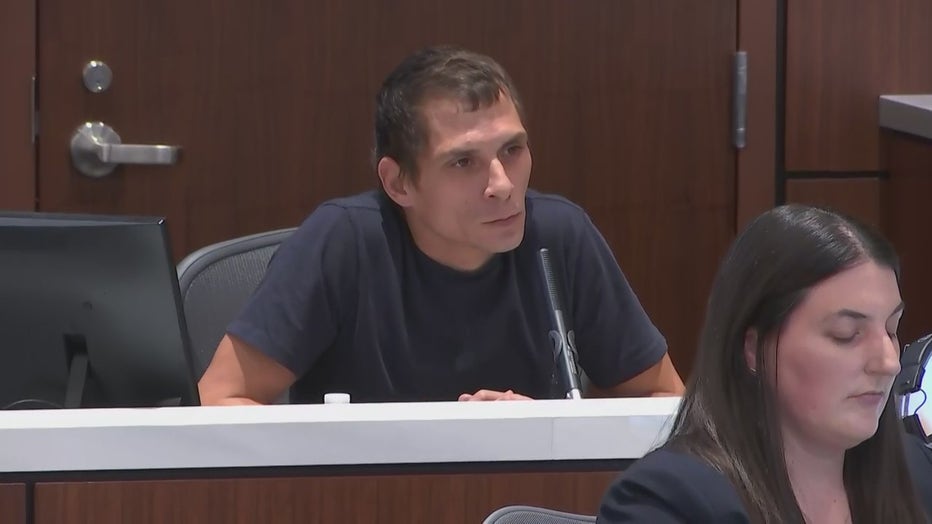
Nicholas Kirby
Kirby then testified about the "physical altercation" between Brooks and Ms. Kori and Ms. Erika. He said he was worried about Patterson getting hurt, so he stepped between then and told Brooks he needed to leave.
Brooks asked whether there was a knife involved.
"No, that is a miscommunication, and I will clarify that," said Kirby.
Dorow stopped Kirby, asking him to wait for Brooks to ask a question.
Brooks asked if Kirby saw Patterson get back into the vehicle. He reiterated that he saw her reach into the vehicle for something. He said he did not see her get into the vehicle.
Kirby said his black jacket he was wearing in the video "hit the ground" as soon as Brooks "started going for the two women."
Brooks asked why.
"Well, if the court don’t hate me for it, I’m just gonna say it’s a good thing there were two women in my way at that moment in time," said Kirby. "That means when my jacket comes off, trouble is going to happen, especially if you are going to try to assault a woman in front of me."
Going back to the report of the knife being involved in this fight, Kirby said, "That was not put into a report. That was a miscommunication between me and an officer. I had been knifed earlier that week and had 12 stitches in one hand. I said, ‘Now, I have a friend being assaulted, and I need back up here.’"
He said when police stopped and asked if there was a knife, Kirby said, "No, there was never a knife involved."
Brooks asked if Patterson ever said the name of the person who assaulted her.
"She was meeting one person that day, and I knew exactly who it was because she had shown me his picture and rap sheet prior. Her child’s father is who she was meeting up with that day, and I told her multiple times, ‘That’s not a good idea. I have a bad feeling about this,'" said Kirby.
Brooks asked questions about the police report, including if Kirby recalled stating that the "alleged defendant" tried to punch and push him.
"The alleged defendant being you, yes -- attempted to," said Kirby.
Brooks asked whether the video showed that.
"No, it does not," said Kirby. "It shows me pulling two women away from the situation."
Brooks asked why he would tell detectives that the "alleged defendant" tried to assault him.
"Probably because there were three people’s fists flying," said Kirby, adding he was trying to protect the two people he cared about.
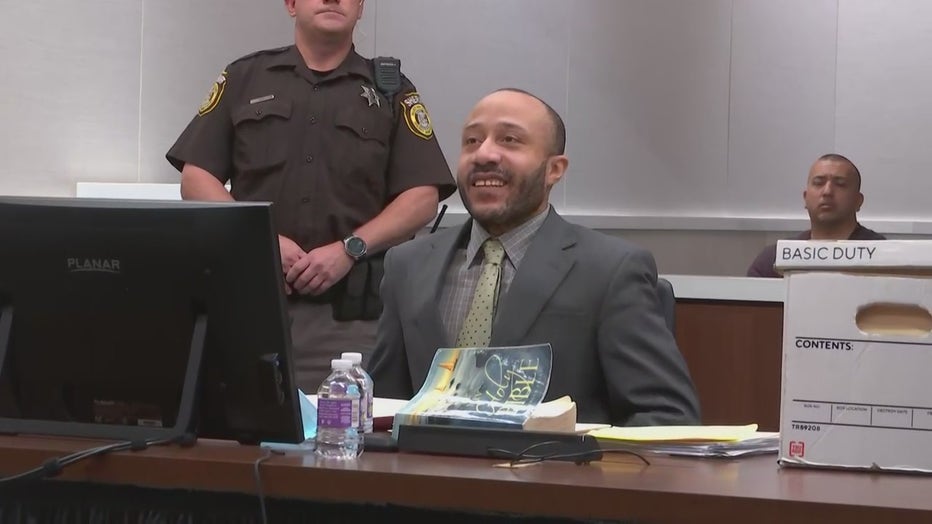
Darrell Brooks in court Thursday, Oct. 20 after questioning his first witness
Brooks asked about the parade.
"I wasn't attending the parade," said Kirby. "I was in the area that the parade route was in. My street is the parade route."
Brooks asked if he saw anyone injured that day.
"Yes, after I walked back through that area, I saw a red SUV take off like a bat out of hell down Main Street and go through a crowd of people," said Kirby.
"The question was, did you see this take place?" said Brooks.
"With my own freaking eyes, yes. How many times do I have to say yes for you to understand it? Y-E-S spells yes," said Kirby.

1-on-1 with Darrell Brooks' defense witness Nicholas Kirby
FOX6's Bret Lemoine spoke one-on-one with Nicholas Kirby, the first man Darrell Brooks called as a witness Thursday as he began presenting his case-in-chief. Kirby said he feels partially responsible for what happened at the parade.
The defendant asked if the video showed three people throwing punches. Kirby said three people were throwing hands: Erika, Kori and Brooks. He said you'll see three pairs of hands go up toward one another in the video.
After the fight, he said they walked back down White Rock to Main, cutting through the neighborhood to go back towards the Women's Center in Waukesha where Patterson and Runkel lived.
"However, things took a drastic turn when the red SUV that I’ve described multiple times went down the opposite direction…then turned back around and came back down…" said Kirby.
The judge struck that response.
Kirby said he was stopped by an officer partway down White Rock, and Kirby let them know they needed to be on the lookout for a red SUV. The officer asked if there was someone with a knife. Kirby said he showed the officer the stitches in his hand and said "no."
"I'm guessing that's where the miscommunication with the knife came in," said Kirby.
Brooks asked if Kirby was injured during the fight. He said he ripped three of the stitches in his hand, but he said that was more from pulling Runkel away from Brooks.
After dropping Patterson and Runkel back at the Women's Center, Kirby said he started running back toward Main Street to see if he could avoid the parade traffic.
"And that’s when I saw the red SUV go down Main Street," said Kirby.
The state had no cross, and the court went into a 15-minute afternoon break.
As the jury returned after break, Brooks mentioned subject matter jurisdiction. The judge said the testimony would continue.
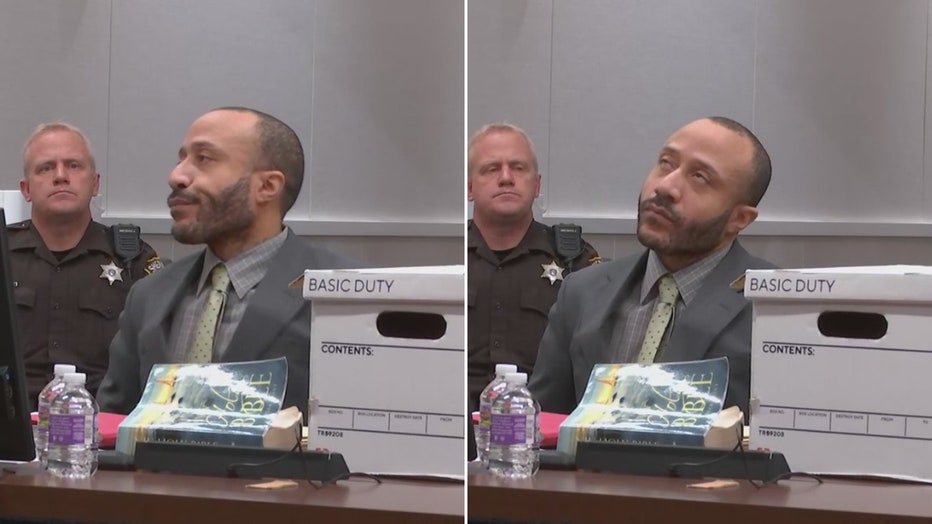
Darrell Brooks reacts to judge's response after witness called on Thursday, Oct. 20
Heather Riemer, Waukesha Christmas Parade attendee
Brooks' next witness was Heather Riemer. Riemer was at the Waukesha Christmas Parade with her husband, three friends and one of their children.
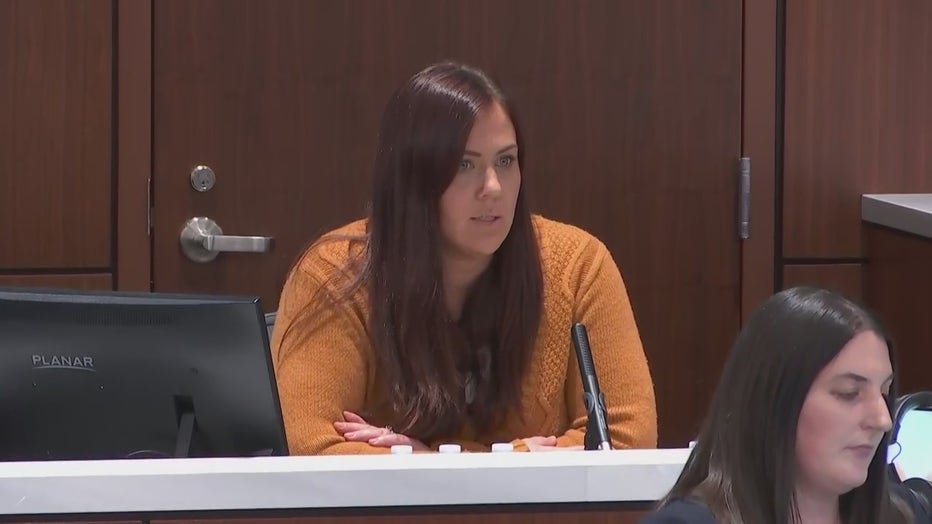
Heather Riemer
Riemer said they were positioned in front of the Waukesha Historical Society.
Brooks asked if she recalled a commotion at the parade. Riemer said "yes." She said she heard "screaming, chaos." She said she then started running, possibly down East Avenue. Brooks asked if that was a side street connected to the main parade route, and Riemer said "yes." He asked whether it was barricaded or if there were law enforcement officers stationed at the side street, and she could not recall. Brooks later asked if any of the side streets were barricaded, and Riemer said "yes."
When asked what she saw during the commotion, Riemer described a red SUV "driving through faster than all the other cars in the parade." She said the horn was honking.
"Well, I heard honking. I’m not positive if it was the red SUV or another car," said Riemer.
Brooks asked Riemer why someone would honk a horn, in her opinion.
"To alert somebody," said Riemer.
She said she did not see the driver of the vehicle and could not recall whether the windows were tinted. She was not able to see into the SUV. She did not get a license plate number. She could not recall if the windows were up or down.
Brooks asked questions about whether she reported what she saw at the parade to police and whether she saw news reports about the parade incident.
Brooks' last question was whether Riemer saw anyone hurt by the vehicle. She said "no."
On cross, Assistant District Attorney Zachary Wittchow asked Riemer to look at the defendant.
"Have you ever seen that man before?" he asked.
"Yes," said Riemer. "As we were driving to the parade, we were coming to a stoplight, and we saw the red SUV coming down the wrong way on the road and I slowed down because the car in front of me started to back up to let him through."
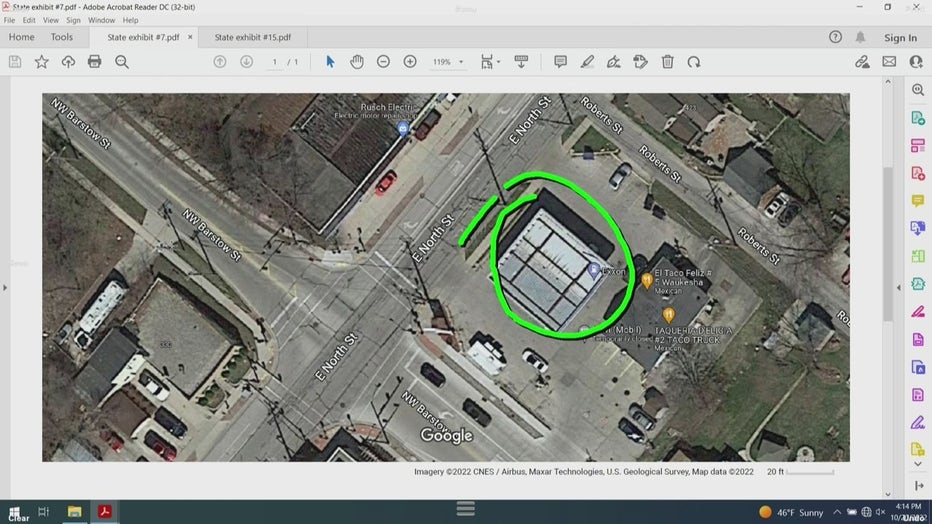
Gas station near where Heather Riemer testified she saw the red SUV before the Christmas parade attack
She said this happened outside a gas station.
Wittchow asked if she saw Brooks at that time. Riemer answered that she didn't know the name at that time but said "yes." She identified him as the defendant in court.
Riemer said she never saw the SUV stop at any point at the parade on Main Street. Wittchow asked if she saw it accelerate, and she said "yes."
On redirect, Brooks asked Riemer questions referencing the map of the gas station. She said "yes" when asked if the SUV she saw at the gas station was the vehicle she later saw at the parade.
"Even though you didn't know if it was tinted or not?" asked Brooks.
Riemer said she could not recall.
At the gas station, Riemer said she only saw one person in the vehicle, at least, there was no one in the passenger seat. She said she couldn't see the back seat.
Brooks asked if she was able to identify the SUV driver based on what she observed at the gas station. Riemer said "yes." He followed up by asking if she knew what the driver was wearing at the gas station. Riemer said "no." Brooks then referenced her interview with police in which she said the driver was wearing an orange shirt. Riemer said that wasn't at the gas station. She said she saw video of him in somebody's backyard. Brooks asked if she gave a description to police based on what she saw in the footage from the backyard. She said the shirt color, yes, but his face was from the gas station.
She said she wasn't positive on the shirt color during her interview with police. Brooks asked if she recalled telling police that since seeing the news, she possibly gave the wrong clothing description. She said she remembered seeing the news, but that's not where she got it from.
Brooks asked how she knows the driver at the gas station was the driver at the parade if she didn't see the driver at the parade. She said the vehicles at both scenes were the same color, make and model -- a red Ford Escape. She added that she knows "a decent amount about cars."
Brooks' last question to Riemer was whether she knew whether the driver of the red SUV was the same at the gas station and the parade. She said "no."
State, judge hope to wrap defense testimony Friday; Brooks says, ‘That’s not gonna happen'
After dismissing the jury, Judge Dorow noted Riemer was called out of order by Brooks following a record made in closed session due to a privacy issue. Dorow said Riemer was unavailable Friday, which was when she was originally scheduled to testify.
There was then a discussion about scheduling. The state asked for Brooks' plan for witnesses Friday, asking whether there were any alterations to his original witness list. The state and judge essentially wanted to know who Brooks planned to call during what time of day (morning/afternoon) so they could inform witnesses as to when they would need to show up in court. Brooks said he would not be providing an order.
This led to a discussion about a particular witness that Brooks said he would not name.

Darrell Brooks trial: Vigorous debate over defense witnesses set for Friday
Darrell Brooks trial: Vigorous debate over defense witnesses set for Friday.
"It's Erika Patterson, your Honor," said Opper. "There's no mystery here."
Brooks indicated he wasn't sure what grouping the witness would be in (morning/afternoon). Brooks said, "What if that's not who I was referring to?"
"You need to tell me right now then," said Dorow, noting that this trial was in its third week, and they needed to keep things moving.
Brooks asked whether it would be fair to say that was not because of him.
"That would not be fair to say," said Dorow.
He said exactly when he opted to call this particular witness could change depending on the flow of the morning. He told the court he wanted to have everyone who wasn't called on Thursday to be present on Friday. Dorow again told Brooks she needed to know who would be testifying during what part of the day. Dorow noted that the state was helping Brooks out in arranging his witnesses. Brooks objected to that, noting it was "the subpoenas..." Dorow then asked whether Brooks wanted to be responsible for calling each witness and informing them as to when they needed to show up in court. Brooks asked how he was supposed to do that from jail.
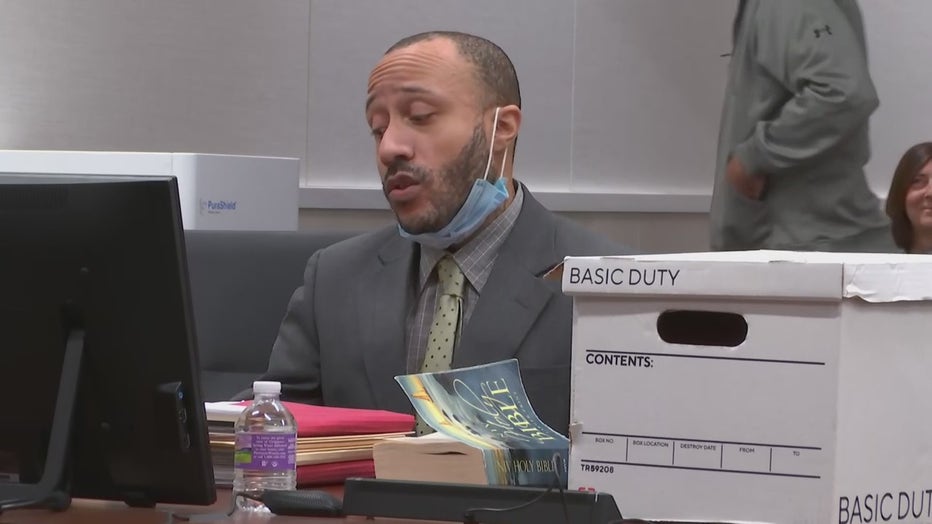
Darrell Brooks in court Thursday, Oct. 20
"Nobody in this courtroom is going to answer a collect phone call…" said Brooks.
Brooks said he did what was asked of him in regard to his witnesses.
Opper said in order for the state to continue to help Brooks with getting witnesses to court, they needed a reasonable time. Opper said she would continue to work from the list that was provided initially by Brooks because she didn't know what else to do.
"These witnesses don't just show up by the Tooth Fairy," said Opper.
Dorow asked what the order was on the original list and the judge gave report times for those groupings of witnesses for Friday.
Opper and the judge said the hope was to complete testimony for the defense on Friday.
"That's not gonna happen," said Brooks.
Christmas parade attack
Prosecutors say Brooks drove a red SUV through the parade route on Nov. 21, 2021, killing six and injuring more than 60 others.
On Nov. 21, 2021, according to prosecutors, Brooks met up with his ex-girlfriend in Frame Park, the same woman he is accused of running over with his red SUV earlier in November 2021. She told police they argued in his SUV before he started driving, and he "was driving around with one hand and striking her in the face with his other hand." She eventually got out and called her friends for help.
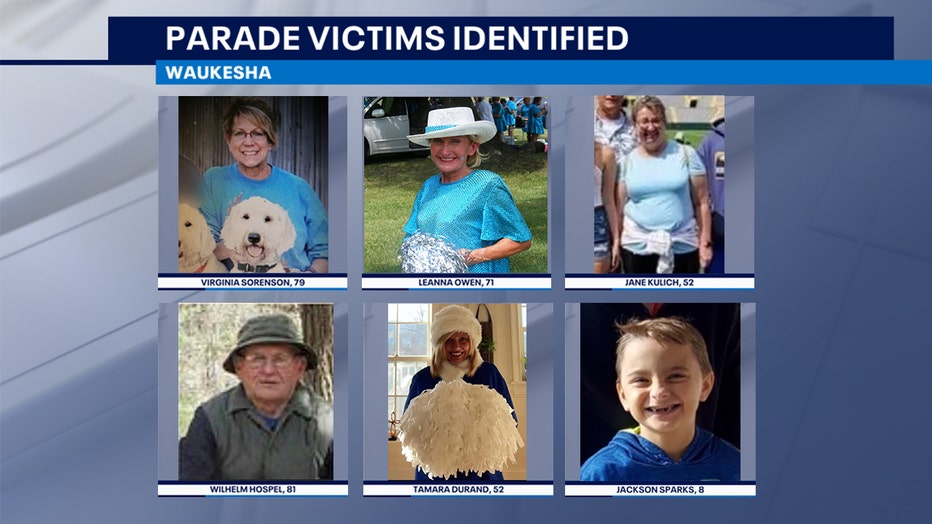
Waukesha parade attack victims identified
Soon after that, according to prosecutors, Brooks drove that red SUV through the parade route, killing Jackson Sparks, 8, Virginia Sorenson, 79, LeAnna Owen, 71, Tamara Durand, 52, Jane Kulich, 52 and Wilhelm Hospel, 81. More than 60 others were hurt.

